Bolognese ...
How the smells of cooking relax us, the importance of Tracy Kidder, the best heat diffuser, plus book and movie and cocktail recommendations ...
I’m reposting this newsletter, written exactly one year ago this week, because, 1, I’m making bolognese; 2, it was the most popular post of 2023 and I wanted any new subscribers to see it; and 3, maybe somebody out there wants to make bolognese this weekend but doesn’t realize it yet! Cheers!
The very first night we had free after posting the last newsletter, I fulfilled a week’s-long obsession, and made Marcella Hazan’s Bolognese sauce. The sky was a deep gray, yellow leaves were beginning to fall on Abingdon Square, and the air had cooled, making this the perfect weather to stay inside and slowly, slowly cook a meaty sauce and fill our small apartment with its rich smells. Ann, having finished the day’s work on her new novel, sat on the couch, cats curled up beside her and knit while she watched her British detective shows, announcing, every twenty minutes or so, “Smells so good in here!”
And I could repair to my al afresco lounge (fire escape) to read Shark Heart, ducking back inside to give the sauce a stir every now and then. Hazan’s recipe asks for a 3- to 4-hour cooking time once the sauce has come together. And this results not only in a fabulous dinner, but it also gives home hours of cooking aromas.
The smells of cooking immediately engage our parasympathetic nervous system and relax us. Our ancient limbic brain knows food is coming and that all will be well. The smells of cooking relieve stress. It’s why Ann called out how good it smelled—because the smells made her feel good. It’s why, when we enter a house where stew is simmering away, we cannot stop ourselves: “It smells so good in here.”
This is part of the greatness and importance of cooking at home.
The sauce itself, recipe and technique …
The meez for this dish couldn’t be simpler: pasta, ground meat, onion-carrot-celery, tomatoes, white wine, dairy, and nutmeg (not pictured below, butter and olive oil).
The above is all there is to it. (Printable PDF of the recipe is at bottom.)
A few changes to the venerable Hazan’s version in her Essentials. All that was available was super lean ground beef, so I added some fatty pork. Also, we don’t drink milk, but we do put half and half in our coffee. Because half and half was at hand, and because fat is what makes this dish, I used it instead of milk (12% fat vs 3.5% fat). And finally, Hazan calls for 1/2 cup onion, but 2/3 cup carrot and celery. Hmm. Not something to get too anal about here. Two carrots, 3 stalks of celery and one half a Spanish onion gave me equal parts of each at about her volume. If you are or have been a culinary student, you know this as standard mirepoix (which typically uses twice as much onion as carrot and celery).
In a heavy pot over medium high heat, sweat the onion in olive oil and a generous chunk of butter till tender, then add the remaining mirepoix and cook till tender.
Add the meat, a four-finger pinch of salt (a good teaspoon) and many grindings of black pepper (don’t be shy). Break up the meat as you cook it. When it has lost its pink color, add the half and half, and many gratings of nutmeg (I did about 15, Marcella suggests 1/8th teaspoon). Cook, stirring until the half and half has completely cooked off.
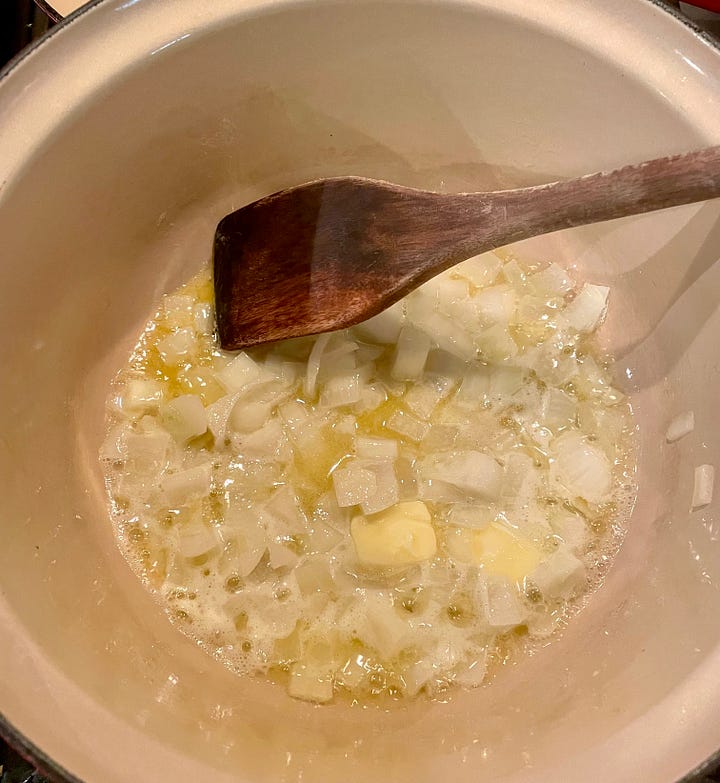
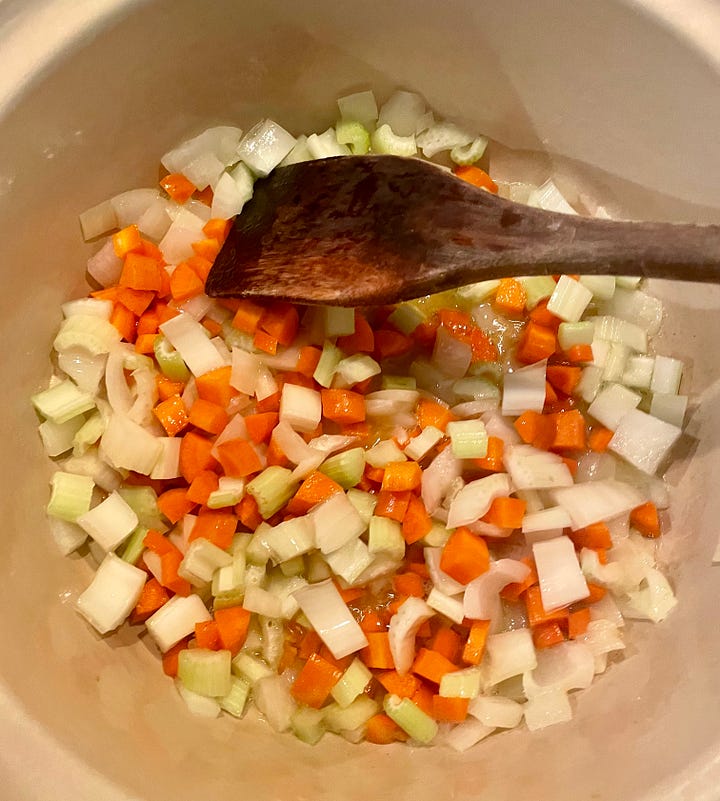

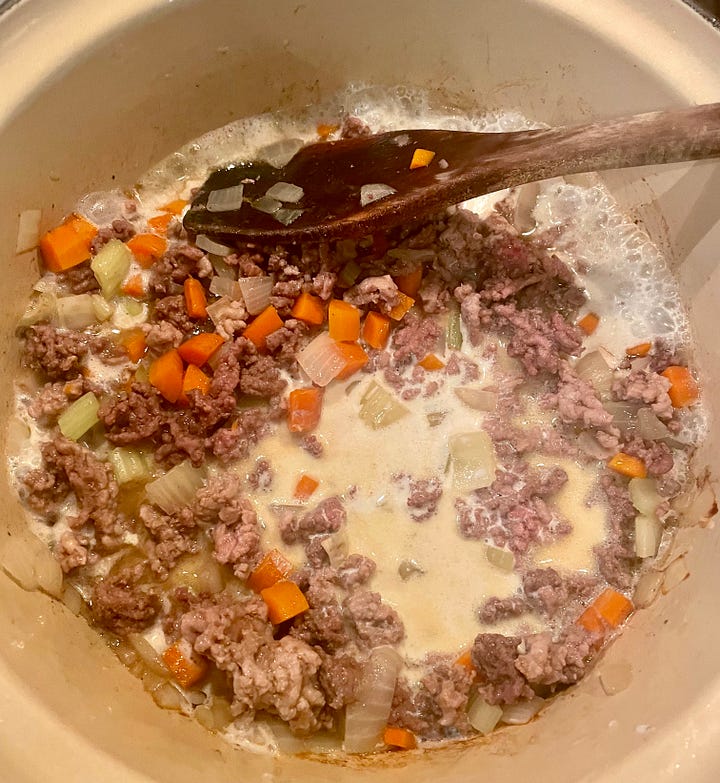
Add the wine and do the same until it is all cooked off.
This was the surprising part for me: she uses very little tomato. This is a meat sauce, not a tomato sauce. I pulled whole peeled plum tomatoes from the can, squeezed their juices into a two cup measure, and broke the tomato up by hand. When I had a cup and a half (from my 28-ounce can), and the wine had cooked off, I added the tomato.
Now the really good part. Simmer this, as gently, gently as possible for 4 hours. (I used my handy heat diffuser, pictured lower down.) Stir frequently. If it starts sticking to the pan, add a quarter cup of water to facilitate cooking (be sure to cook it all off before serving; all you want is the fat). Taste and add more salt and pepper if you wish.
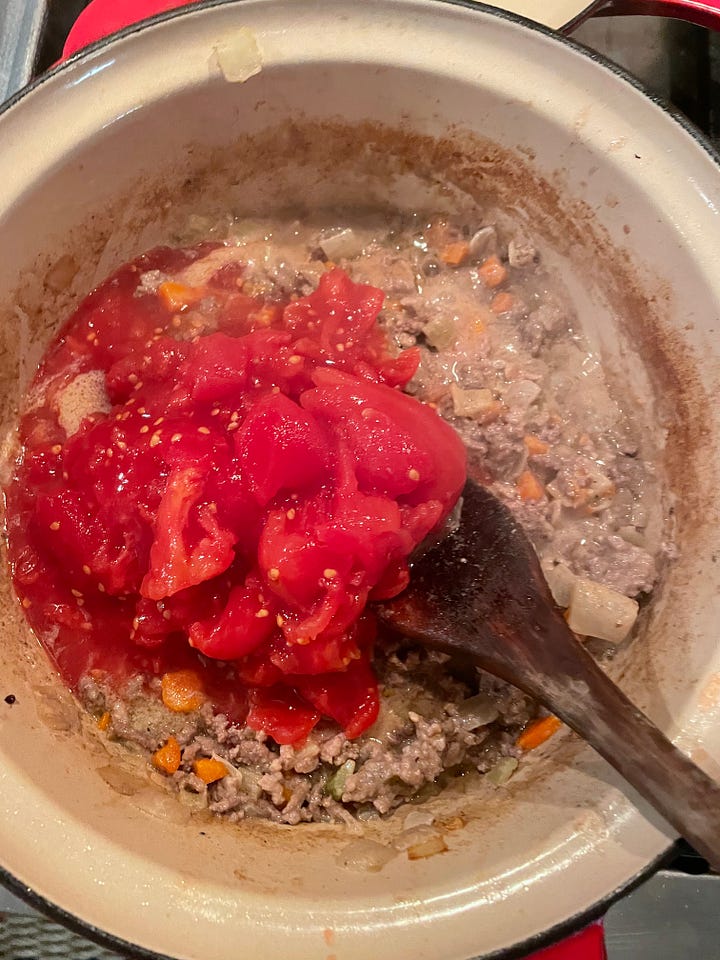
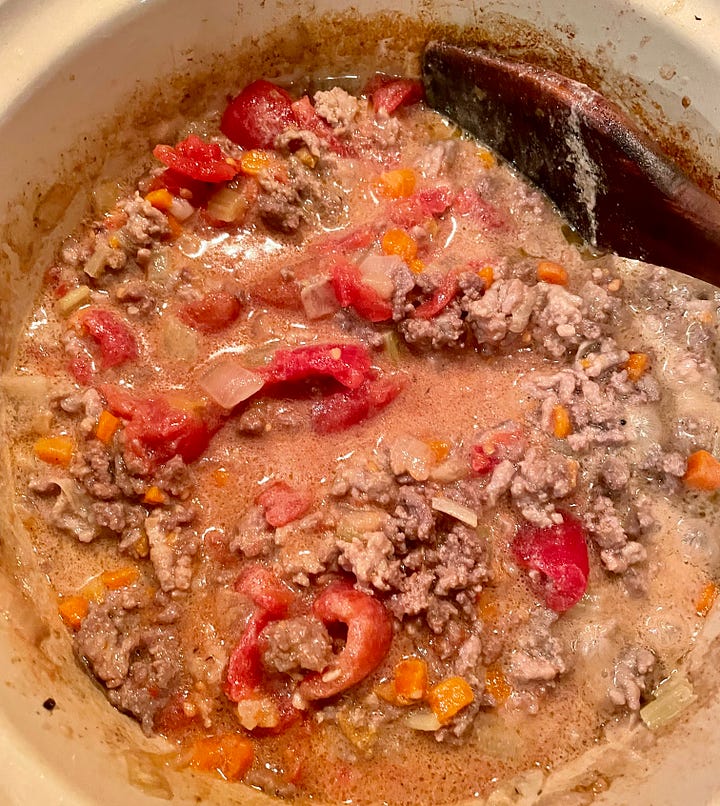
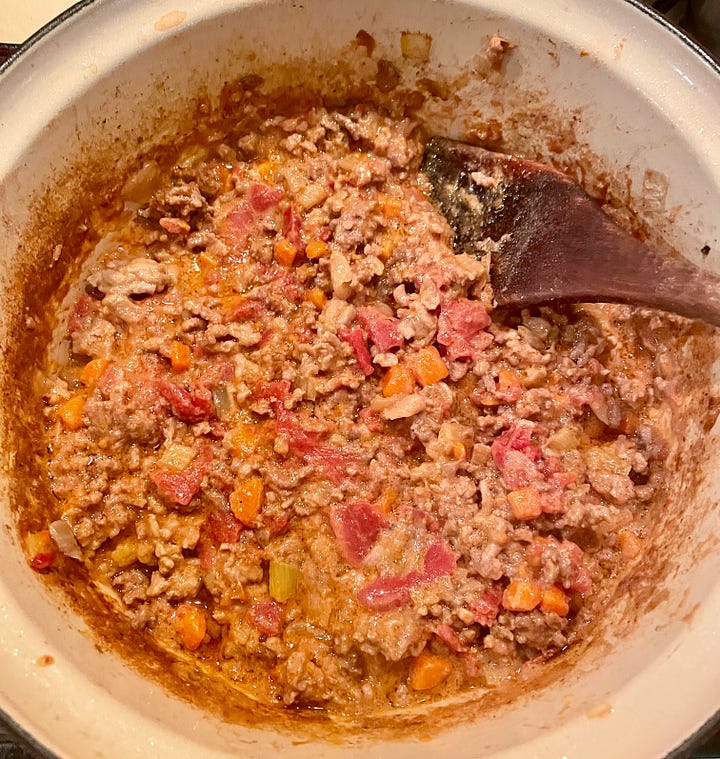
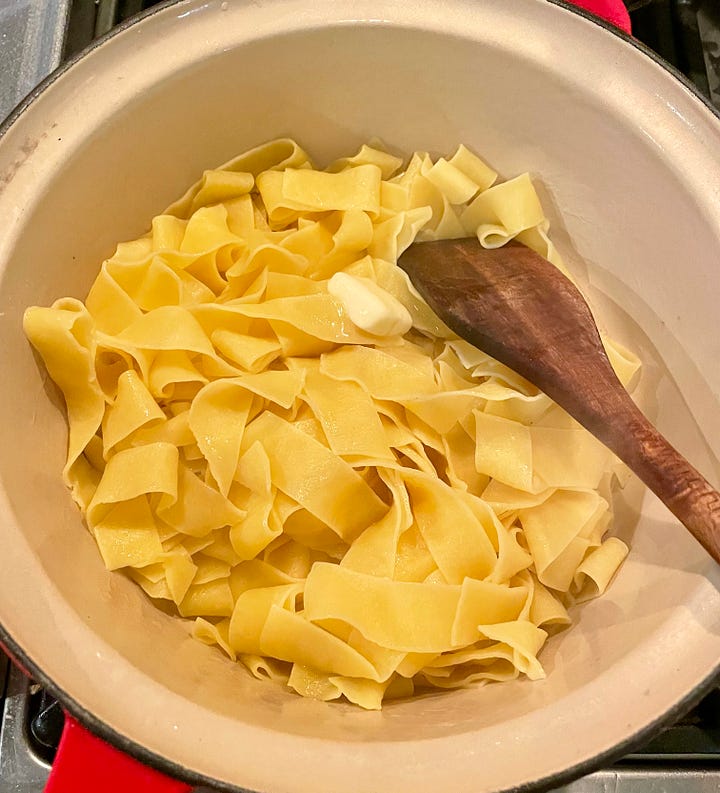
Toss with freshly boiled pasta.
If you’re hanging at home on a gray chilly fall afternoon, there is no better meal to fill the house and the belly with.
Brattleboro Lit Fest and Tracy Kidder …
Ann and I were lucky enough to be invited back to the Brattleboro Literary Festival in Vermont last weekend. I did a horror/noir panel for Cleveland Noir (short stories, and one noir poem, set in my fair hometown), and Ann and I did a joint presentation, she for Fly Girl and me for The Book of Cocktail Ratios.
We got to see friends like poets Wyn Cooper and Diana Goetzch, YA novelist Patricia Park, Tim Weed, Bill Roorbach—too many to name. But for me the most important event was Tracy Kidder’s reading from his new book, Rough Sleepers, and the discussion that followed.
When I could only aspire to be a writer, after I’d completed my second novel that didn’t sell, I began to explore non-fiction. John McPhee was the non-fiction king, of course, but it was at this time, my late 20s, that I discovered Kidder: first with House, then back to his Pulitzer-winning The Soul of a New Machine, to Among Schoolchildren. That this kind of book-length non-fiction existed was a revelation.
Of course I’d read books like In Cold Blood and The Electric Kool-Aid Acid Test, but Kidder was writing about ordinary people doing ordinary things (teaching fifth graders, building a house). It was a revelation. And reading his books, I’m certain, helped me to sell and write my first book, Boys Themselves, about an all-boy school that was defiantly single sex at a time when anything all male was considered toxic.
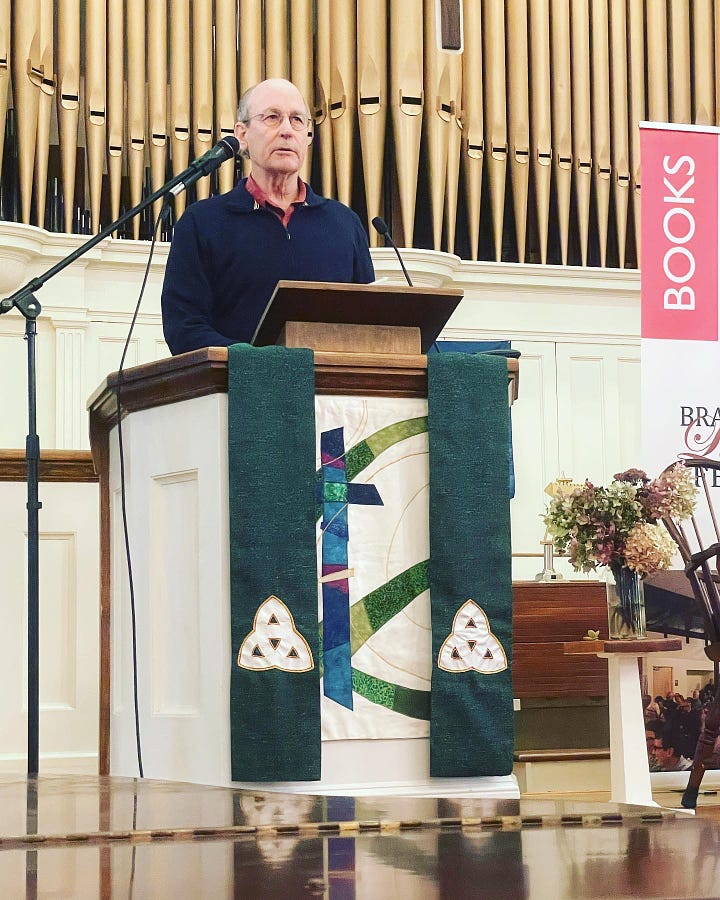
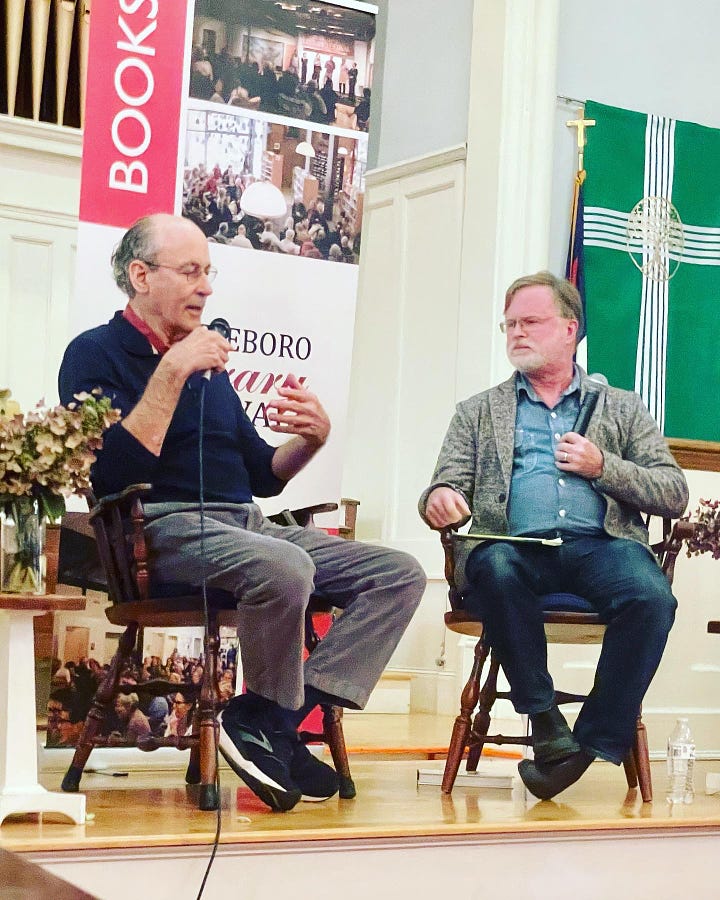
It was a pleasure to meet Mr. Kidder. To learn that he’d aspired to be a novelist but had found that well dry, as he put it. And to hear how he works, how he hangs out and listens. How he too gets mad at himself when he’s transcribing a recording to hear himself butting in and not letting the subject talk. He’s a lovely man.
The best heat diffuser …
I don’t remember when I thought to do this. I was cooking and needed a heat diffuser. Then I realized it was already on the stove! This is how I minimized the heat for Hazan’s bolognese.
Yet another fabulous use for the all-purpose cast iron skillet.
What we’re drinking …
One of the writers we spent time with in Brattleboro was Will Schwalbe who was there talking about his book We Should Not Be Friends. Will is also an editor at large for Macmillan and lives around the block from us in the West Village.
As it turned out, his favorite cocktail was the Pegu Club, a gin sour in the Margarita family named for the place where it was created, the British officer’s club in Yangon in what is sometimes called Burma.
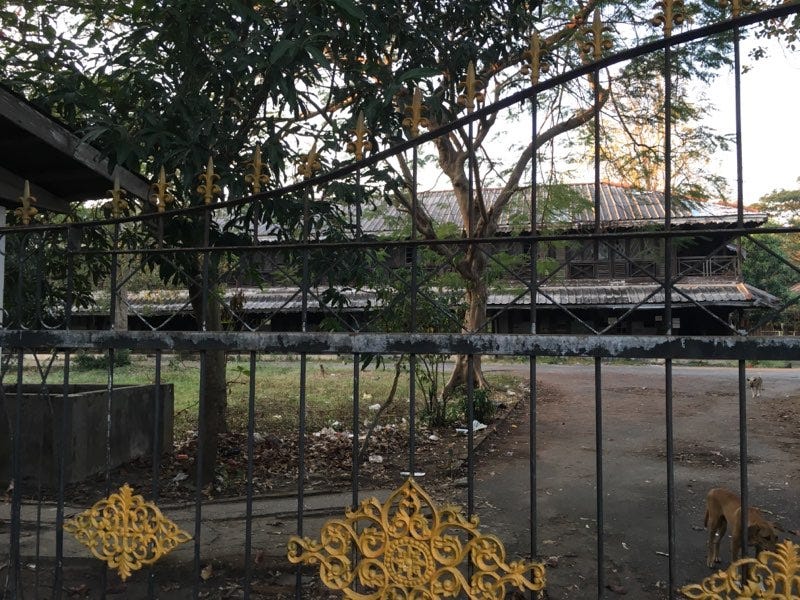
And so that is this week’s cocktail. It’s fabulous.
The Pegu Club
2 ounces gin
3/4 ounce Cointreau
1/2 ounce lime juice
1 teaspoon simple syrup (optional)
Dash Angostura bitters
Dash orange bitters
1 lime wedge
Combine the gin, Cointreau, lime juice, and simple syrup (if using) in a mixing glass or shaker, add ice, and stir or shake till chilled. Strain into a chilled coupe or an old-fashioned glass over ice. Add the bitters. Garnish with the lime wedge.
Note: I think the simple syrup, while optional, is important. It’s just a bit too tart otherwise, but you really need all the lime.
What We’re Watching …
Have to lead with one of the best movies we’ve seen since Barbenheimer: Anatomy of a Fall. It’s a psychological thriller about two writers who live in the remote French Alps with their nearly blind 11 y.o. son. Almost immediately after the film begins, the husband, more of a failed writer than his successful wife, is found dead on the ground outside their house. Was it a suicide or did the wife kill him? The movie explores this for 150 riveting minutes. It won the Palme d’Or at Cannes for a reason. Highly recommend.
The Wonderful World of Henry Sugar, Wes Anderson’s 41-minute adaptation of the Roald Dahl story, is mesmerizing with Benedict Cumberbatch as the title character, a wealthy man trying to learn how to cheat at cards. The highly stylized sets, which create almost two-dimensional scenes, are classic Anderson and they work beautifully here. (A relief after Anderson’s last two disappointing films, Asteroid City and French Dispatch.) On Netflix, highly recommend.
On the flight home from London, I watched the latest Indiana Jones movie—fabulous. Harrison Ford is outstanding even at, hard to believe, 80 years old. And a cameo by an actor in the first film had all teary-eyed by the end.
Ann watched a different movie, one I hadn’t heard of:
I watched Call Jane, a movie based on a true story of a network of activists providing underground abortions in the 60s and 70s. When Roe v Wade is passed at the end and the Janes are all jubilant, I was acutely aware of how important it is to watch this movie during these strange times.
In Flora and Son, which we streamed at home, Eve Hewson stars as a single mother of a delinquent child she had as a teenager. She is at her wits end when she decides to take the gift of a guitar for her son, who didn’t want it, and learns to play in a one-on-one online course with an LA guitar teacher and failed songwriter (Joseph Gordon-Levitt, whom I always love). I liked this predictably feel-good movie better than Ann but I especially appreciated the way the director brought Gordon-Levitt out of her laptop and into her life without his having to leave LA. Moderate thumbs up from both of us.
From Ann the Knitter:
When I heard Unforgotten has a Season 5, I was shocked. No one can replace Nicola Walker, DCI Cassie Stuart who shockingly died at the end of Season 4. But Kay Gardiner, fellow knitter and lover of British crime shows, recommended it so I was there. Knitting my ballband dishrags, immediately on board with Season 5. If you haven’t seen this show yet, start with Season 1 and warn your family you won’t be available for a bit.
Ann read and liked Bonnie Garmus’s novel Lessons In Chemistry. The book has been turned into a series on Apple TV. It’s TERRIBLE. I can’t all-caps that enough. We couldn’t make it through the first episode. Horribly written, horribly acted, horribly directed. Even the cats were throwing up. Seriously.
What we’re reading …
I am midway through a book that Ann will talk about here and which I mentioned above, the highly unlikely fabulist tale, Shark Heart. It, is, astonishing.
And I will let you in on a small secret, one of the lucky things about being married to a novelist. I am also reading Ann’s novel-in-progress, a time-travel love story. The unlucky part is that I won’t know how it ends until after she does. Her new novel, happily, will be out in May: The Stolen Child, about an unlikely duo’s attempt to solve the mystery of a child’s fate as they travel through France and Italy.
This week’s recommendations from Ann:
I cannot recommend Shark Heart: A Love Story by Emily Habeck enough. I’ve simply never read anything like it. When I tell you the premise, you might think this isn’t a book for you. But it is. It is! From the book jacket:
For Lewis and Wren, their first year of marriage is also their last. A few weeks after their wedding, Lewis receives a rare diagnosis. He will retain most of his consciousness, memories, and intellect, but his physical body will gradually turn into a great white shark.
From me: Yes, but this book is about love and grief and motherhood and just please read it.
I read Helene Hanff’s epistolary novel 84 Charing Cross Road many years ago, long enough ago to justify buying this beautiful reissue at Waterstones in London when I saw it. In 1949, New Yorker Helene Hanff begins a correspondence with Marks & Co. Booksellers in London in search of rare editions. For the next twenty years she writes to various employees of the bookshop and entire lives unfold along the way. So important is the shop and the people who work there that when a friend visits London Helene tells her: “If you happen to pass by 84 Charing Cross Road, kiss it for me! I owe it so much.”
Readers of this newsletter know of my love for West by Carys Davies and her new novel, Clear, which I was lucky to read in galleys but can now be pre-ordered for its April release. I’m deep into her novel The Mission House now and it’s as wonderful as the other two. In fact, all I want to do is read it with a cat or two on my lap and the cool autumn air filling our little apartment. Hilary Byrd flees his life and demons in England for a village in south India where he hopes to find solace. A possibly helpful minister, a possibly helpful rickshaw driver, and a young woman all intersect with Byrd as he struggles to connect with people, place, and himself.
Links we’re loving …
Ann turned me on to this very funny substack,
, in which the British author, Lucy Sweet, reviews ridiculous products, such as these feel-good-about-yourself products. I also want to give a shoutout to ’s La Briffe.And finally, substack-wise, I really like
’s Blood & Whiskey monthly newsletter, with more book reviews, crime and cocktails.The NYTimes says you shouldn’t rake your leaves. But if you do, make art out of it. (Kottke.org)
Food52 wants you to bake with cardamom, one of the most beguiling spices I know.
I’ve assigned my food journalism class several essays from The New Yorker this week that have been a pleasure to analyyze in class. Butter, by Akhil Sharma; Filter Fish, by Oliver Sachs; and The Lamb Roast, by Gabrielle Hamilton. All are about food and identity, food and loss. (Newyorker.com; possible paywall)
Confessions of a tableside flambeur. (Eater.com)
And speaking of Yangon, why does its country use two names? (AP)
And finally …
We’re happy that the writer’s strike has ended and happy to have SNL’s Weekend Update to make us laugh. But the world is too much with us, Pete Davidson and Lorne Michaels know. Here is Davidson’s uncommon cold open on the importance of comedy in the face of tragedy.
And that’s all for this week folks! Thanks for reading. Click the heart button—it makes me happy. Leave a comment, ditto! And if you’re a free subscriber and like the newsletter, please consider becoming a paid subscriber.
Have a great weekend!
—Michael



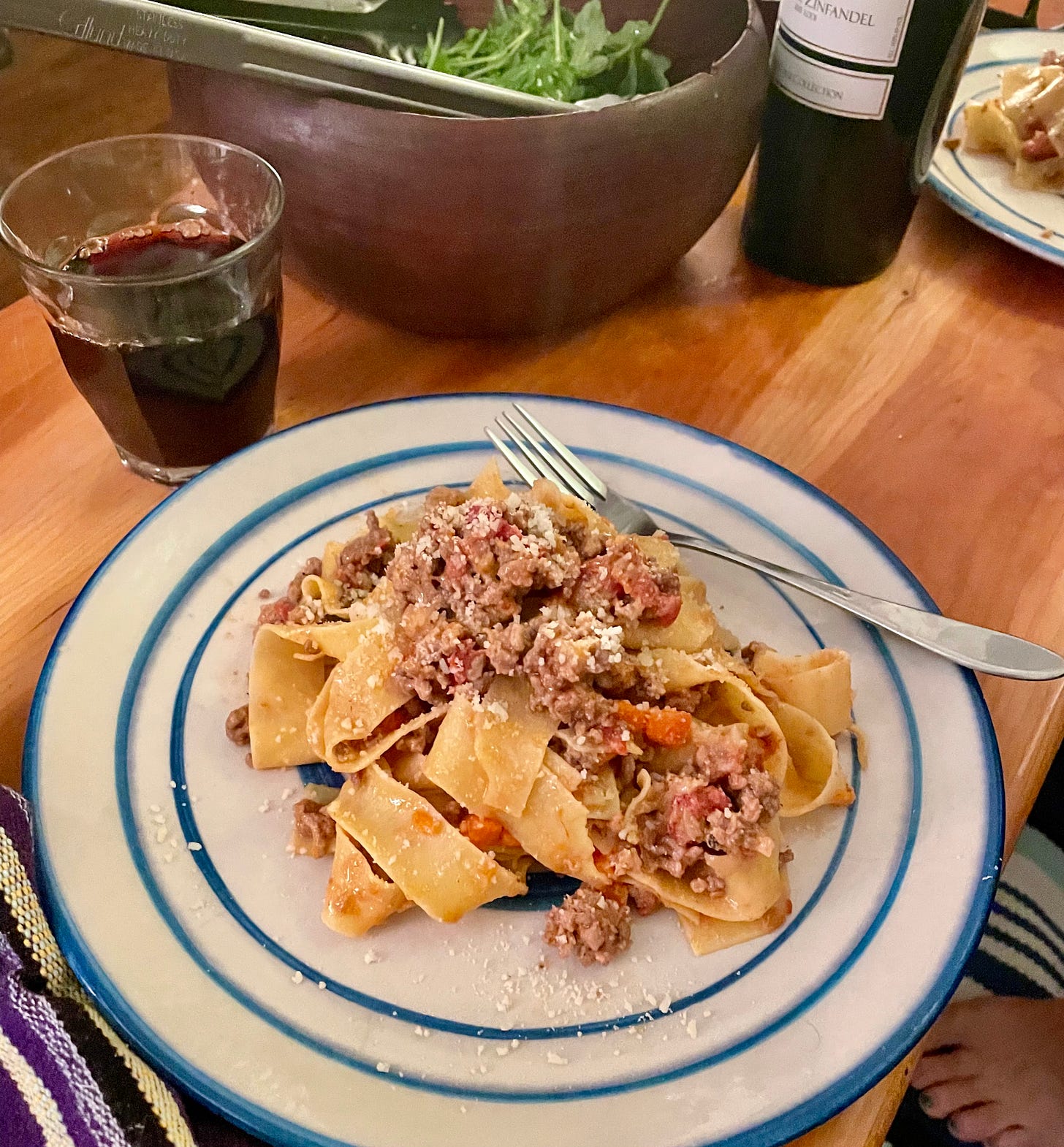
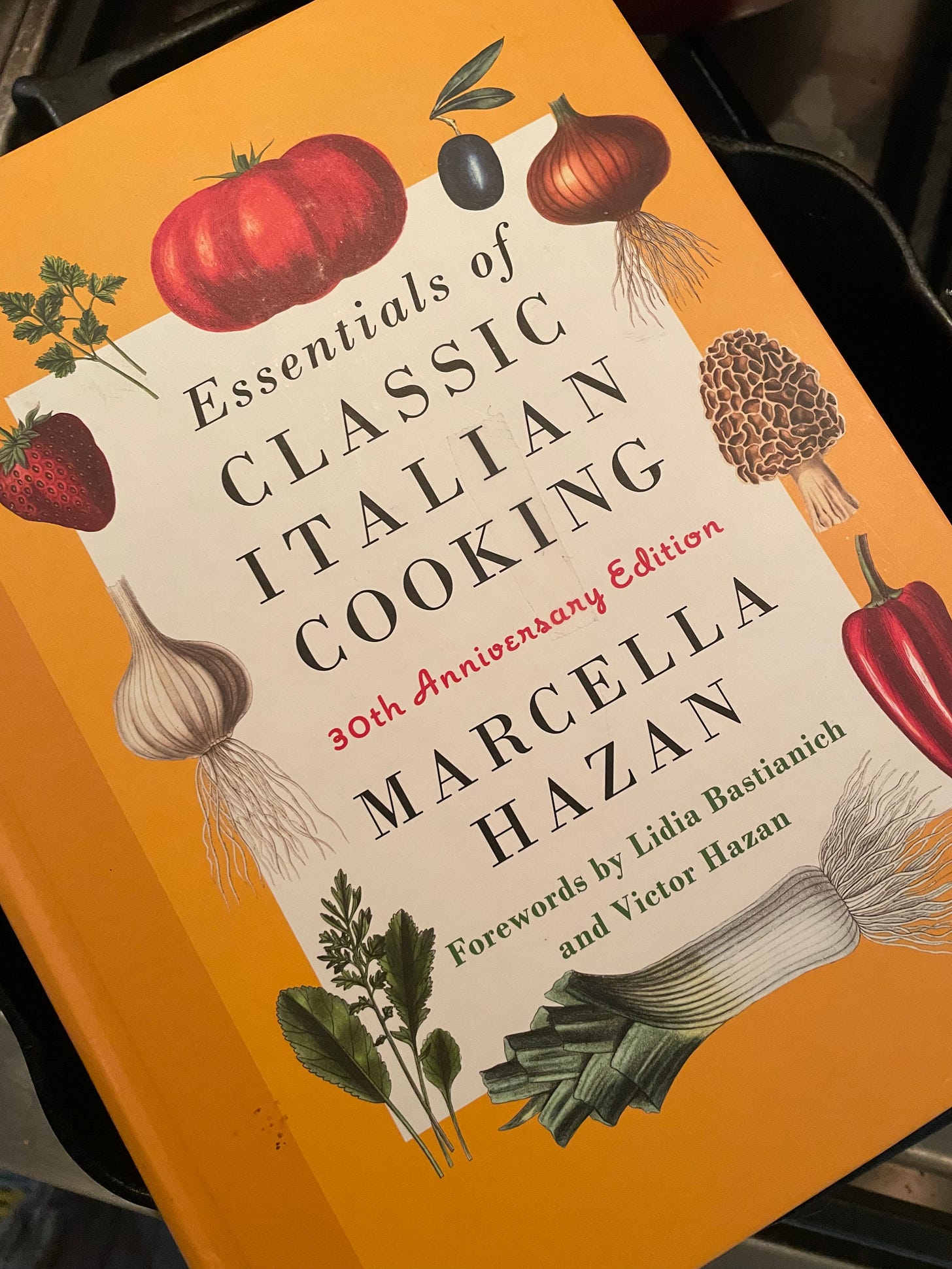
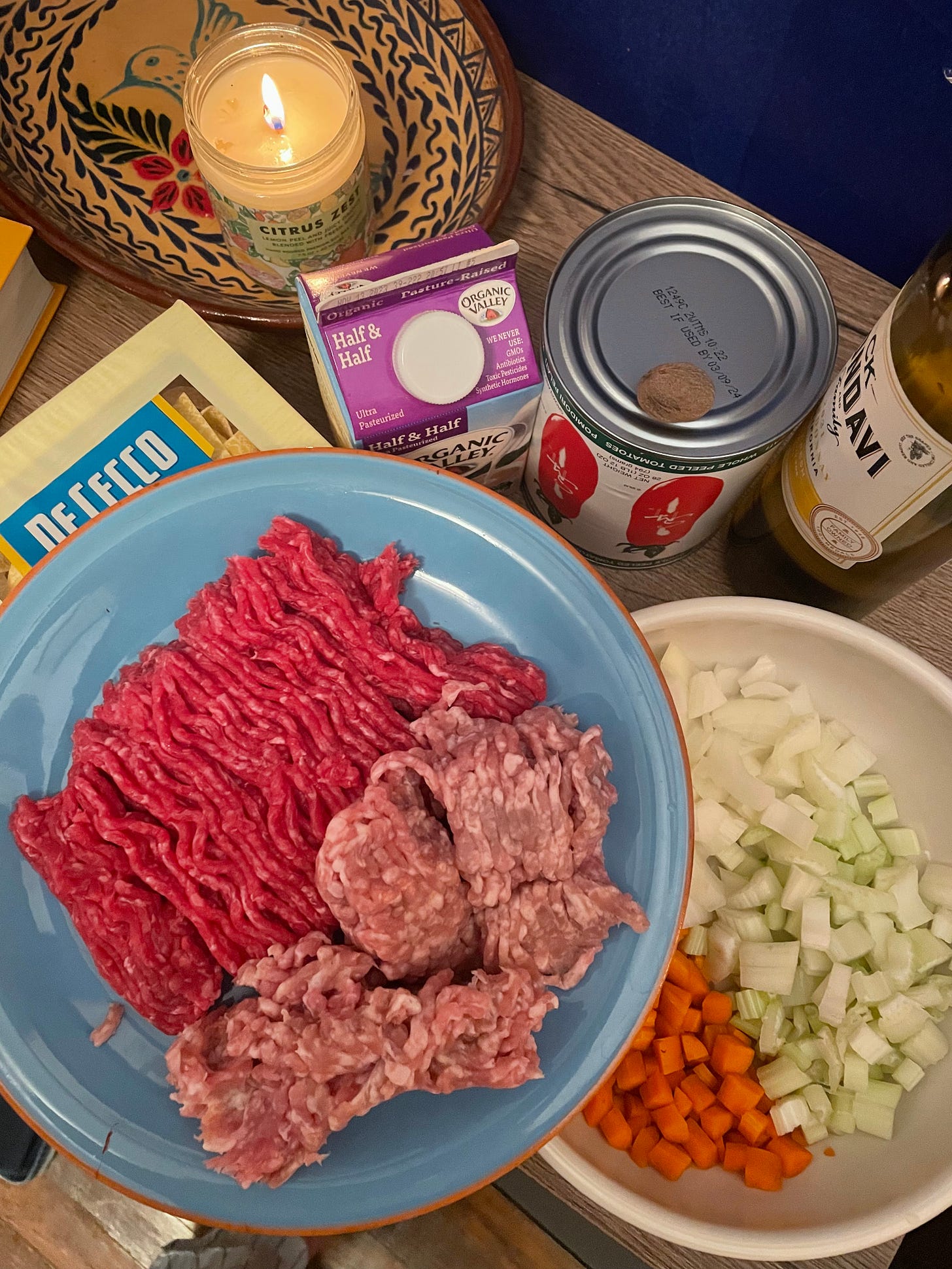
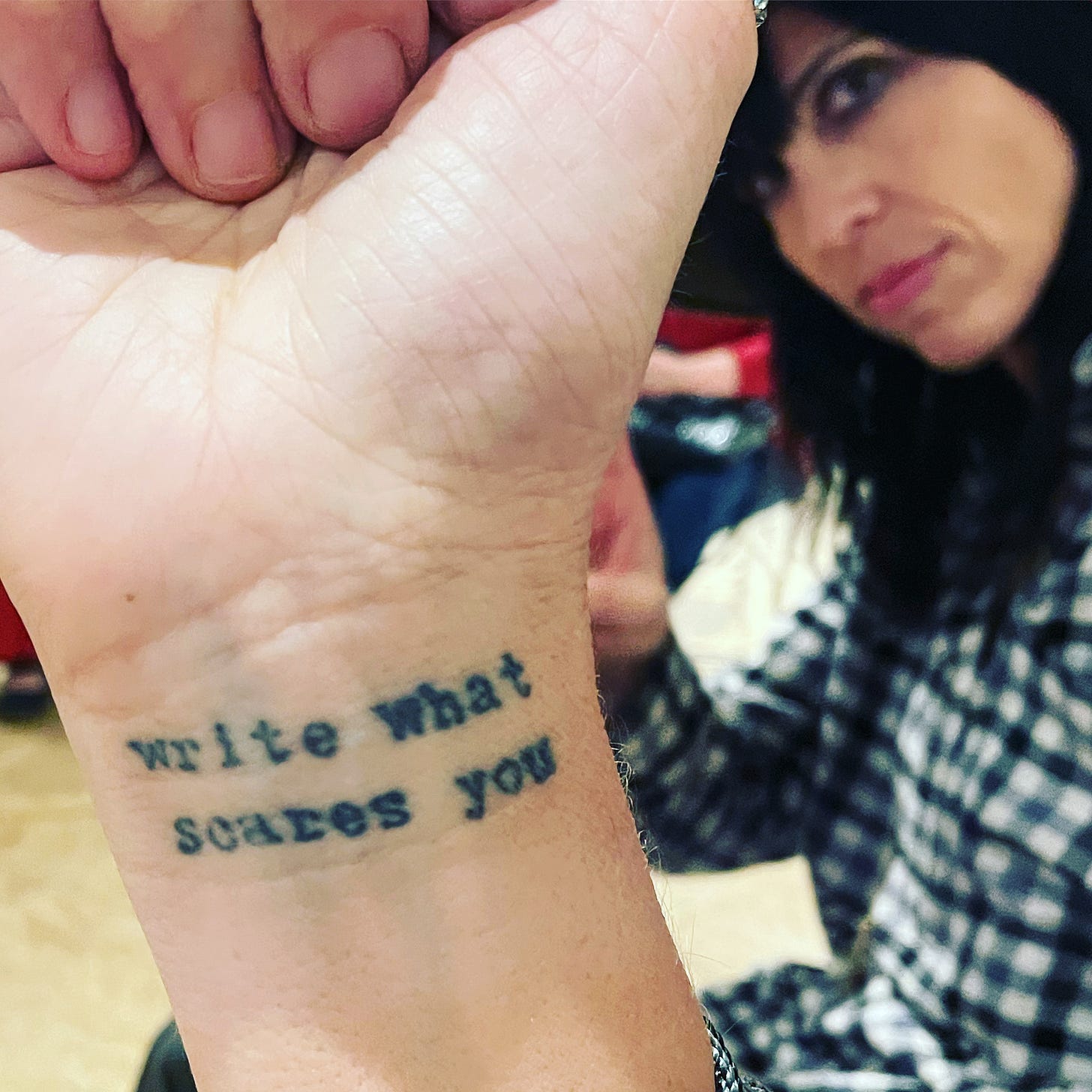
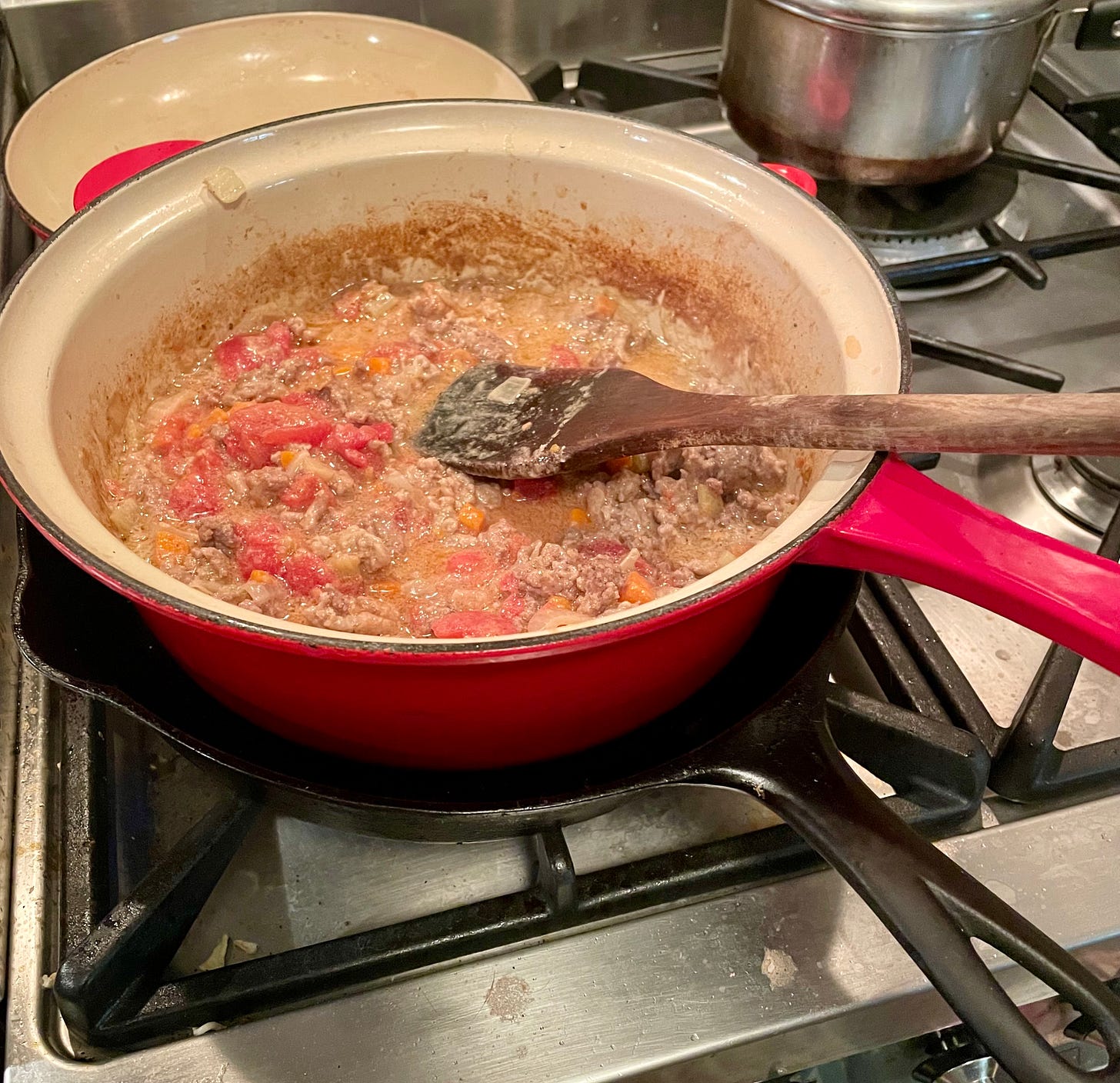
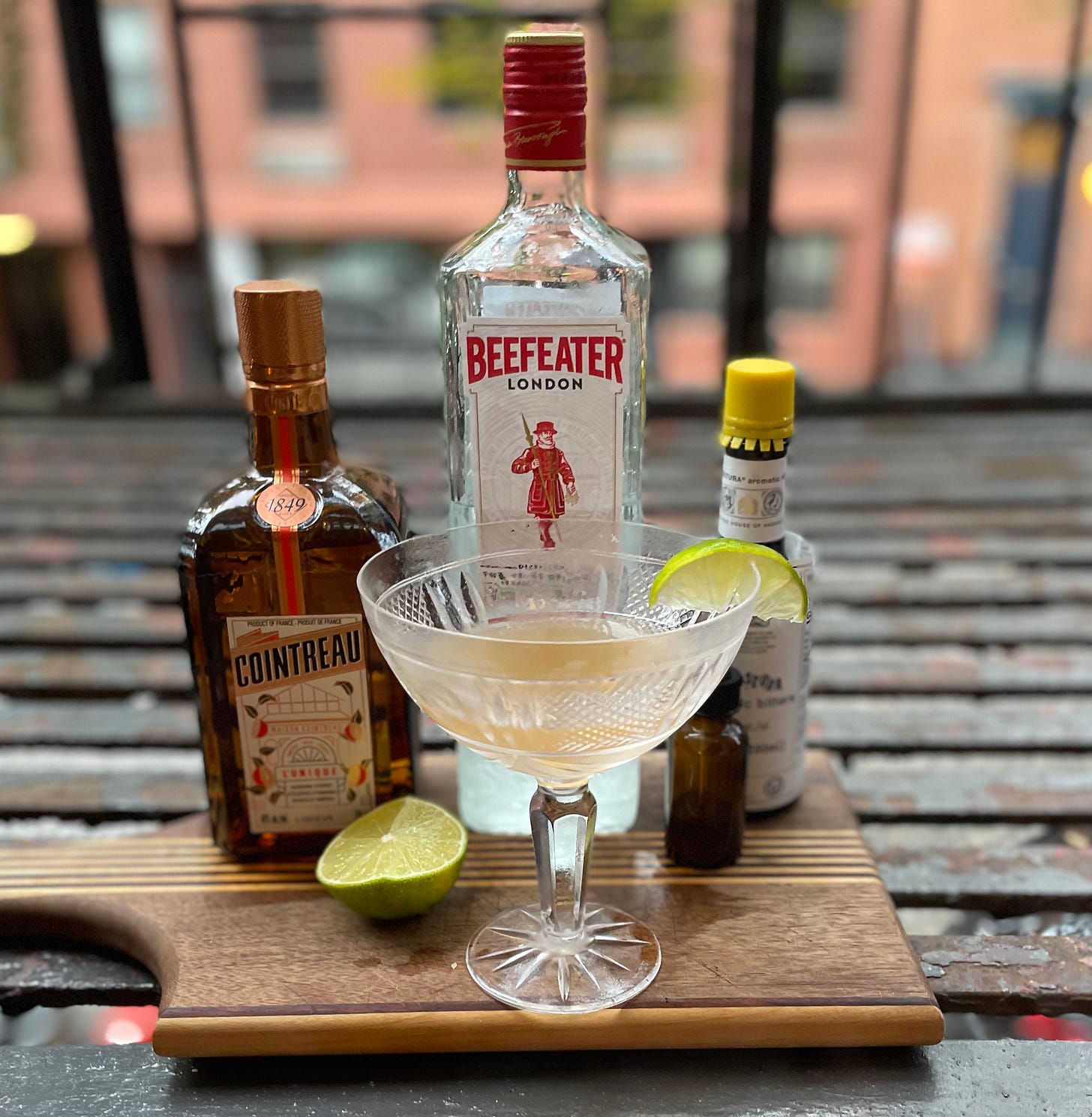
I'd love to use my cast iron skillet if I could figure out how to get the damn rust off.
Thanks for the repeat shoutout for Blood & Whiskey, Michael! Had a Pegu Club last night and toasted you and Ann.